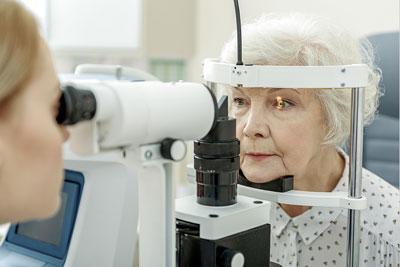Glaucoma Information, Symptoms, and Ophthalmologist Recommended Treatment Options
Lowering eye pressure slows or halts the progression of glaucoma.
Your doctor will determine an eye pressure target based on the initial eye pressure and the amount of damage present.
Eyedrops are typically used as the first approach to lower eye pressure. The eye will have a healthy pressure when fluid production and drainage are balanced. Some drops decrease the amount of fluid that the eye produces. Other drops improve drainage inside the eye. Often several different eyedrops are necessary to achieve the eye pressure target. Eyedrops are not without side effects. Mild burning or stinging, cosmetic changes, allergic reactions, and systemic side effects are possible.
When eyedrops are not enough, laser trabeculoplasty can remodel the drain of the eye. This procedure lowers the eye pressure. For closed-angle glaucoma, lasers can be used to perform laser iridotomy.
If both eyedrops and laser trabeculoplasty remain ineffective, glaucoma surgery is usually recommended. Microincisional techniques revolutionized glaucoma surgery with faster healing and a lower risk of complications. Summit Eye Center is at the cutting edge of these new and improved glaucoma surgeries. Canaloplasty is like angioplasty for the eye. A catheter is threaded through the drainage canal of the eye and a stent is placed to increase drainage in the eye.
Although new surgical techniques for glaucoma are promising, some patients are not candidates for these procedures. Some need a trabeculectomy or glaucoma drainage device to create a new drain for the eye. These procedures are the most effective in lowering eye pressure, but have a higher complication rate.
A complete eye exam will detect glaucoma damage.
 Examining the optic nerve for damage is the most important aspect.
Examining the optic nerve for damage is the most important aspect.
The optic nerve typically has healthy tissue extending to the blood vessels in the center of the nerve. As glaucoma damages the optic nerve, the optic cup enlarges in the center of the optic nerve. In advanced glaucoma nearly all the optic nerve is gone and blindness is imminent.
The eye pressure is a balance between the fluid produced in the eye and the fluid drainage from the eye. Measuring eye pressure helps detect glaucoma. Most people have measurements between 12 and 21. Usually glaucoma elevates eye pressure, but sometimes glaucoma damage occurs at “normal” pressure.
The corneal thickness is also measured to determine the accuracy of the eye pressure measurement. Gonioscopy, direct examination of the drain of the eye, is performed to look for scar tissue obstructing the drain inside the eye. If the optic nerve or eye pressure is abnormal more detailed tests for glaucoma are performed. These include a visual field test and computerized optic nerve scan. An abnormal test result confirms the presence of glaucoma damage.
Glaucoma Classification
An ocular hypertensive has an elevated eye pressure but no evidence of glaucoma damage on visual field testing and optic nerve scan. If the eye pressure is less than 30 and few risk factors for glaucoma are present, observation and repeat glaucoma testing every 6 months is recommended. If the eye pressure is less than 30 and significant risk factors for glaucoma are present, treatment is recommended. If the eye pressure is greater than 30, the risk of developing glaucoma is so high that treatment is recommended.
A glaucoma suspect has an abnormal optic nerve appearance but no evidence of glaucoma damage on visual field testing and optic nerve scan. Repeat glaucoma testing is recommended every 6 months to monitor for the development of glaucoma.
Open angle glaucoma or “normal” eye pressure, and glaucoma damage on visual field and/or optic nerve scan. Treatment is initiated and discussed below.
While there is no cure for glaucoma, severe visual loss is usually avoidable. The treatment of glaucoma represents an important, lifelong partnership between the doctor and the patient.
Glaucoma FAQ
Glaucoma is the second largest cause of blindness in the United States.
It causes increased pressure in the eye which damages the optic nerve. Generally an age-related condition, glaucoma can be detected at your regular eye exams.
Symptoms of open-angle glaucoma include a gradual loss of peripheral vision or tunnel vision. Symptoms of closed-angle glaucoma may include severe eye pain, blurred vision, halos around lights, a reddened eye, and a sudden onset of visual disturbances.
If you are experiencing symptoms of closed-angle glaucoma, please contact our office immediately.
Glaucoma is detected through eye pressure tests administered during your regular office visits.
These visits should occur every other year between the ages of 40 and 60, and yearly after that. Early detection allows Dr. Skelsey to effectively treat this common disorder.
Glaucoma is treatable, but cannot be cured.
To treat glaucoma, Dr. Skelsey will relieve the pressure in your eye. Depending on your needs, he will use medications, surgical instruments, or new laser therapies. During your glaucoma evaluation, he will find the best method for you.
Content reviewed by Kevin R. Skelsey, M.D., F.A.C.S.
